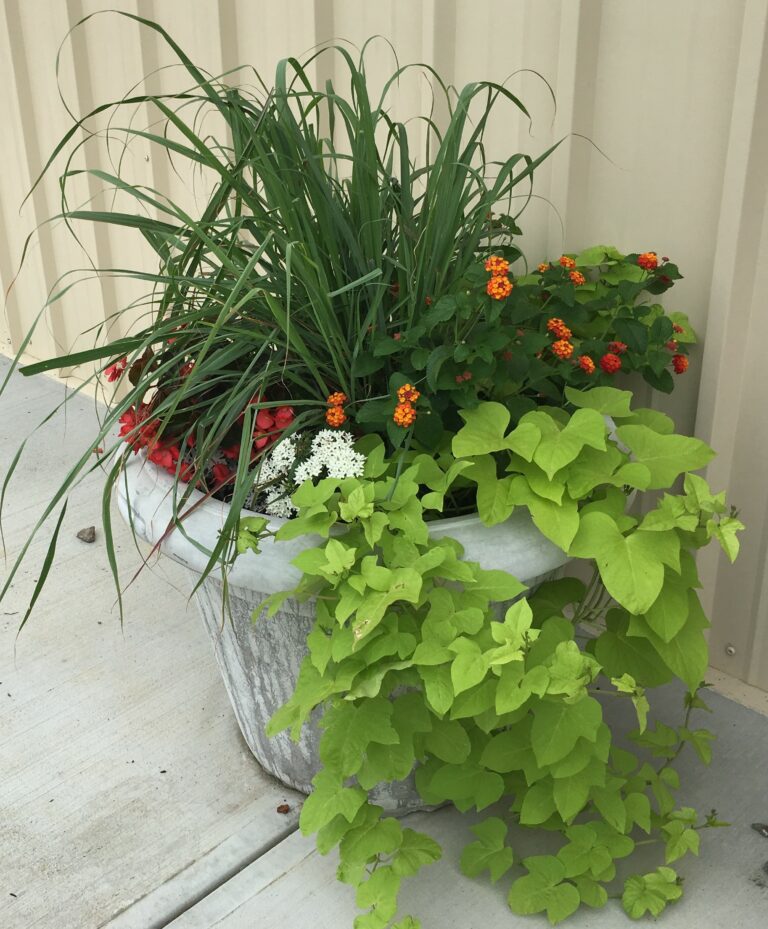Lawn
- Recycle your clippings as you mow instead of bagging and discarding them. Returning these clippings to the law saves time, energy and money. Grass clippings contain 4% nitrogen, 1% phosphorous, 3% potassium and smaller amounts of other essential nutrients
- Try to change direction when mowing your lawn. This will help strengthen the roots system and expose different sides of the plant to sunlight.
- Fertilize bermudagrass and St. Augustine lawns at a rate of 1 lb. nitrogen per 1,000 sq. ft., equal to 6 lbs. of 16-4-8 per 1,000 sq. ft
- Install a rain sensor to your irrigation system to avoid watering during or immediately after rain. Adjust irrigation applications according to rainfall, so that a total of 1″ of water is applied each week.
Trees, Shrubs, and Flowers
- Pinch off garden mums till mid-July to encourage branches and delay flowering until fall.
- Many people have container gardens on their patios and porches. Container-grown plants can dry out quickly during these hot, summer days. Daily watering may be necessary, however, the soil shouldn’t be soggy or have standing water. Apply water until it runs out the drainage holes. Feel the soil in containers at least once a day and twice on hot, dry days to be certain that plants are getting enough water.
- Prune spring-flowering shrubs such as azaleas, forsythia, and hydrangeas as their blooms fade. Be sure to prune them by mid-July to avoid cutting off next year’s flower buds.
- Reduce the mosquito population by emptying standing water. Mosquito larvae need only a small amount of water to grow. Empty any open container of water, including saucers under plants and birdbaths, every two or three days to prevent larvae from reaching maturity.
- Remember to prune suckers from flowering trees and shrubs like crape myrtles, crabapples, apples, pears, and more. Pruning out these suckers will improve the appearance and can reduce the chance of some diseases that are attracted to the young, succulent growth.
- A second application of slow-release fertilizer is needed in mid-summer for containers and flower beds
Fruit, Vegetables, and Herbs
- If you are growing herbs, remember to harvest before they flower for peak flavor or aroma. Pick herbs in the morning when the dew has dried off, when the aroma will be the most intense.
- When watering vegetables from overhead or with a sprinkler, the best time of day to water plants is early in the morning. Watering during mid-day allows excess water evaporation. Avoid watering in late evening when the foliage can not dry before the sunsets. Wet foliage on hot summer nights is a perfect environment for diseases to start.
- Keep tomato plants mulched and evenly moist to reduce blossom end rot and cracking.
- Certain pesticides have a waiting period of several days between the time of the last spray and harvest called “Harvest Interval Date.” Read and follow directions on all labels before applying to your vegetable crops. Wash all produce thoroughly before use.
- Pick beans, squash, and tomatoes regularly to increase production.
- Remove lower suckers on tomatoes and lightly fertilize to keep production going.
Jessica Strickland is an agriculture extension agent, specializing in horticulture for North Carolina Cooperative Extension in Wayne County.

